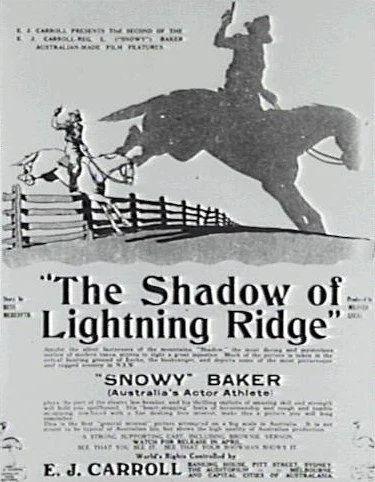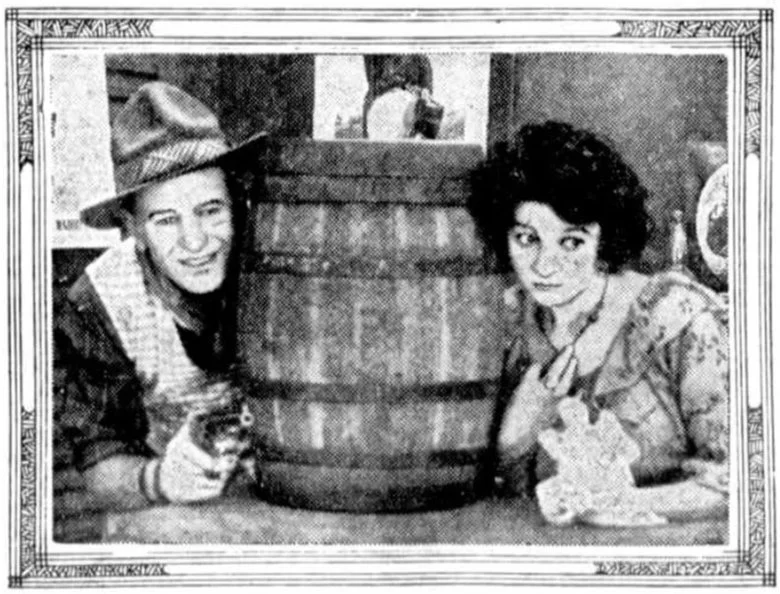The Shadow of Lightning Ridge
Film poster for The Shadow of Lightning Ridge, 1920.
In 1920, the silent feature The Shadow of Lightning Ridge put Lightning Ridge’s name up in lights. Directed by Wilfred Lucas from a script by Bess Meredyth and starring champion athlete “Snowy” Baker with American actress Agnes (Brownie) Vernon, the film is now a lost work. Very little survives beyond posters, press notices, and movie reviews in old newspapers.
The story is a Zorro-style melodrama, transposed to the Australian bush. A masked outlaw known only as “The Shadow” targets the wealth of Sir Edward Marriott, a mine owner en route via train to Lightning Ridge with cash and his reluctant fiancee Dorothy. After hold-ups, kidnaps, rescues and bushrangers, the outlaw wins Dorothy’s heart. The Shadow then learns Dorothy is heir to Sir Edward’s estate, and deftly escapes an attempt by a character named “Portuguese Anne” to turn him in to the authorities.
Lightning Ridge gets top billing in the title and is mentioned as part of the plot, but the film was not shot in northern New South Wales, rather it was filmed near Sydney, on location at Bulli Pass and in E. J. Carroll’s Palmerston studio at Waverley, no where near the opal fields. Contemporary research about the film mentions miners and a station (farm), suggesting perhaps Sir Edward’s wealth may be opal-related, but in the absence of any surviving film material or script, it is impossible to know. It is also impossible to know if the production attempted to reproduce the Ridge’s landscape at all. It’s very likely no one connected with the film ever visited the district.
Snowy Baker and Beronice Vere, in “The Shadow of Lightning Ridge” (New Lyceum and Lyric). Photograph: The Sun, 16 May 1920.
Accuracy aside, the film was little more than a vehicle to leverage Snowy Baker’s stunts. Reviews swoon over Baker’s feats: leaping from horseback onto a moving train, driving a horse through a roof, and even a plunge from a cliff into water below. Publicity suggests he insured himself for £5,000; other reports claim some sequences used a stunt double.
The film was said to be very “American”. The Bulletin admired the photography but scoffed at the Wild West plot. Local trade papers called it “the best Australian production to date”. Box office takings from its 1920–23 run were strong enough to help launch the Carroll-Baker Film Corporation.
For the town of Lightning Ridge, the film’s significance is wholly an exercise in early name recognition. Barely a decade after the first opal rushes and with the town only just appearing on maps, “Lightning Ridge” was already synonymous with the frontier, the Wild West, adventure, spectacle and thrills. Later productions on the field would more accurately represent the opal fields, but Wilfred Lucas’ The Shadow of Lightning Ridge was the pioneer.
Stuart Lloyd showed an interest in the film, reaching out to the Commonwealth Film Unit while researching for The Lightning Ridge Book. Unfortunately, he was unable to get any particularly interesting information beyond some casting and crew notes. The producer-in-chief of the CFU recommended he contact the camera man for the film, Mr. Al Burne. The Lightning Ridge Historical Society holds Lloyd’s correspondence with the CFU among his research documents.
Article: Research by Russell Gawthorpe and Leisa Carney, edited by Russell Gawthorpe. LRHS research compiled by Len Cram and Barbara Moritz. Sources: The Lightning Ridge Book, Stuart Lloyd, 1967, p. 112; IMDb, title tt0012668; ‘The Shadow of Lightning Ridge’, Kadina and Wallaroo Times, 2 October 1920, p. 2; ‘The Shadow of Lightning Ridge’, The Australian Worker, 1 April 1920, p. 19; ‘The Shadow of Lightning Ridge’, 17 April 1921, p. 4; ‘The Shadow of Lightning Ridge’, Northern Star, 5 August 1920, p. 2; ‘Amusements. Earl’s Court’, The Morning Bulletin, 11 November 1920, p. 9; ‘The Moving Row of Magic Shadow Shapes’, The Sun, 16 May 1920, p. 16.



